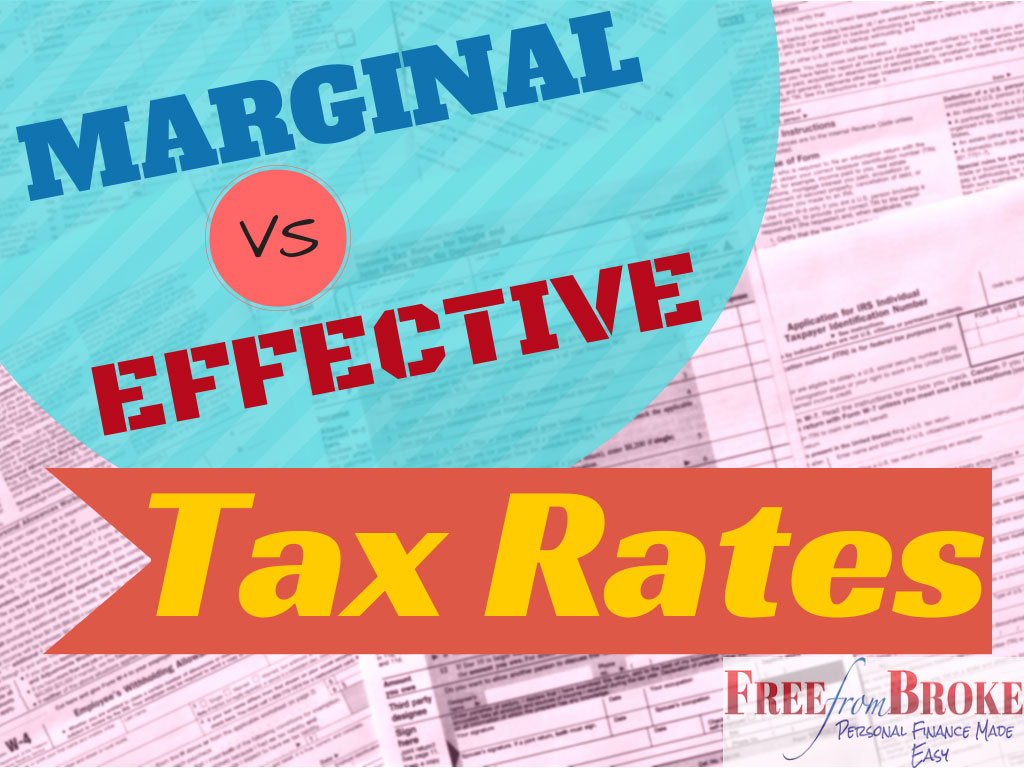Pop Quiz – What’s your effective tax rate for 2014? How about your marginal tax rate?
Don’t worry if you’re not sure.
Truth is most of us have no idea what either our marginal or effective income tax rates are.
They only seem to matter at income tax filing time, usually appearing as supplemental numbers in a computer generated income tax return.
One of the reasons we tend not to track these numbers is because they’re calculations, which for the most part, have no immediate relevance to us, but also because of complications in calculating them.
Because we have a progressive income tax system — tax rates rise with income — and because there are multiple taxes, the actual numbers can be difficult to calculate. In addition, each rate can change from one year to the next or from complications in the tax code.
We have two tax rate classifications then, marginal tax rate and effective tax rate.
Keep reading and you’ll learn the difference between the two as well as why it’s important to know the difference between them.
What is the marginal tax rate and the effective tax rate and how and when do they apply?
Marginal Tax Rates
Simply put, marginal tax rates are the rate of tax that applies to the last dollar of our income.
For example, if you’re married filing jointly and your taxable income is $100,000, you’re said to be in the 25% marginal tax bracket because your last dollar of income is subject to tax at a rate of 25%.
The example above represents the most common use and understanding of the term “marginal tax rates,” but there are a few complications.
You have to understand that the point about the rate you are paying on the last dollar of income.
Even if you are in the 25% marginal tax bracket you aren’t paying 25% on your entire taxes.
You are only paying that rate for the amount of money over that bracket’s minimum. Up to the that point, you are paying a lower percentage for the income that falls into the lower bracket. This happens throughout all the marginal tax brackets (it progresses are your income increases).
Also, our incomes are subject to multiple taxes, not just federal income tax, but also state income taxes, Social Security and Medicare taxes (known as “FICA” taxes) and sometimes municipal income taxes and/or state unemployment insurance.
What this means is that your total marginal tax rate is something higher than the one that’s usually quoted.
You might be in the 25% marginal tax bracket for federal income taxes, but on top of this you might add, say 7% for state income taxes, 7.65% for FICA, and say, 2% for municipal income taxes, for a total marginal tax rate of 41.65%.
This rate can be further changed by complications in the tax code.
For example, your income or deductions might cause the Alternative Minimum Tax (AMT) to take affect, or your earnings beyond a certain level may cause the Social Security portion of your FICA tax to drop off.
Though it’s not usually stated to include all forms of income taxation, the true marginal tax rate is almost always a good deal higher than the one everyone quotes.
Effective Tax Rates

Effective rates are the average rate of taxation that applies to our income.
To put it mathematically, it’s our total tax liability divided by total income in any given year.
If you earned $100,000 in income and paid $18,000 in federal income taxes, your effective rate would be 18% ($18,000 divided by $100,000).
Just as with marginal rates, effective rates are usually expressed only in terms of the impact of federal income taxes. If we add FICA taxes and state and local income taxes to the equation, we’ll get a more accurate picture of what percentage of our incomes are actually paid in income taxes, even though this isn’t usually how they’re calculated or discussed.
Effective tax rates help us to know how much of our income is going to pay income taxes, rather than predicting what rate additional income will be taxed at.
It’s an interesting rate because it shows what we actually paid in taxes across all marginal tax brackets and after all credits and deductions.
You might cringe when you see what your marginal tax rate is but let out a sigh of relief when you see your effective tax rate.
Why You Need to Know the Difference
For starters, there’s “bragging rights” — both marginal and effective tax rates are an indication of higher income and thus a subtle way to brag about it.
You might say “I’m in the 35% tax bracket,” which is a more socially acceptable way of bragging about your $300,000 annual income without disclosing how much you actually earn. All you need to do is disclose a high tax bracket and people can figure out the rest.
But there are more constructive reasons too.
As we all know, we don’t actually collect all of our earned incomes — to know how much we’ll actually receive from a given level of income we have to factor in how much it will be reduced by income taxes.
By knowing what your marginal tax rate is you’re in a position to know what the net take will be on additional income.
Let’s say for example that you’re in the 28% marginal tax bracket; that means you’ll bring home 72 cents out of every additional dollar of additional income.
It can also help you to determine the point of diminishing returns.
Say you are in the 35% bracket for federal income tax and 10% for state income tax—that’s a combined marginal tax rate of 45%. But you might also add an additional 7.65% to cover Social Security and Medicare taxes, for a grand total of 52.65%.
What this means is that out of every dollar of additional income, slightly more than half will be paid in taxes.
This is the point at which many would say that “you’re working for the government” since more than half of all income goes to various government agencies in the form of taxes. Based on this calculation, you might decide that the effort to pursue additional income won’t be justified by the heavy tax burden (or you’ll work more diligently to find ways to be more tax efficient).

Tough to be in the 35% bracket and still be paying social security (FICA). (Possible of course if you are under the FICA cut-off, but the spouse’s high income has you in that bracket.)
Great article about taxes. It’s amazing that most people spend more time knowing and caring for their favorite teams than to know about these very vital financial matters that impact their lives directly.
Good explanation! I want to print this out to show some folks. It drives me nuts when people in the xx% tax bracket complain about paying xx% of taxes on EVERYTHING they earn! It doesn’t work that way!
It is amazing how many people don’t realize the difference between the two…it is one of those things that I always assumed people just knew since everyone has to file their taxes (bad assumption!)
I honestly didn’t always understand the brackets and how they worked. I guess most probably don’t either.
Think about doing your taxes – it’s either done online or by a CPA, where you wouldn’t really see the brackets anyway. Even if you do them yourself, you look for the range your AGI falls into and take that number and put it where you are instructed.
It’s one of the things that I talk to tax customers about all the time.. That last dollar of income is really getting whacked. I see so many people taking second jobs to get ahead who are floored by the higher tax bite.
Here’s an idea. How about flattening the tax on wage income. Anything over $40k will be taxed at the long term capital gains rate. Guess what? A lot more work will get done and families will move up faster.. When live brings you lemons, make lemonade!
As JoeTaxpayer points out, Social Security taxes drop off when a person hits a certain income threshold. So once a person hits that threshold, their marginal tax rate drops significantly.
A while back, I created a spreadsheet that calculates marginal and effective tax rates. Because I live and work in California, my tax rates are significantly higher than most people’s. In addition, I am self-employed and must pay both the employer and employee portions of FICA taxes. You start to see some interesting developments when you track these numbers over a period of years.
For example, from 2011 to 2013, my income more than doubled, yet my effective tax rate was nearly identical (18.5%-19%). And had FICA not temporarily been reduced by 2%, my effective tax rate in 2011 would have exceeded 20%. This was primarily a result of having two additional children and a large contribution to a SEP plan in 2013.
For 2013, the people who have the highest marginal tax rates (here in CA) are single, self-employed, have ~$120,000 of earned income, and no children. They pay a marginal tax rate that exceeds 52% and an effective tax rate of nearly 38%. (Of course, contributions to deferred tax retirement accounts would lower these percentages.)
From the supplemental information in the computer generated 2014 income tax return packet received from my accountant, the marginal tax rate is 15% and the effective tax rate is 21.1%. I do not understand how the effective tax rate can be higher than the marginal tax rate. Can someone offer an explanation of circumstances that could result in this situation… of put another way, are there any circumstances that could result in the effective tax rate to exceed the marginal tax rate? Might an overpayment of estimated taxes cause the situation or is the calculation based on tax liability vs. taxes paid?
Will, why not ask your accountant? That does seem to be an interesting difference there. I’d love to know how that happened.